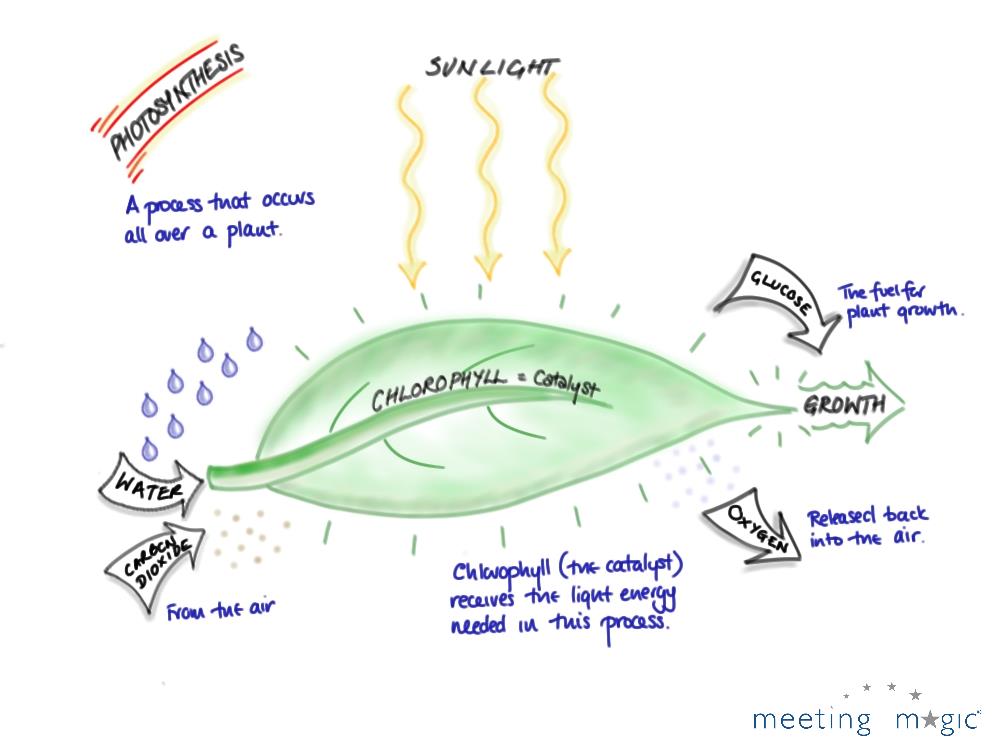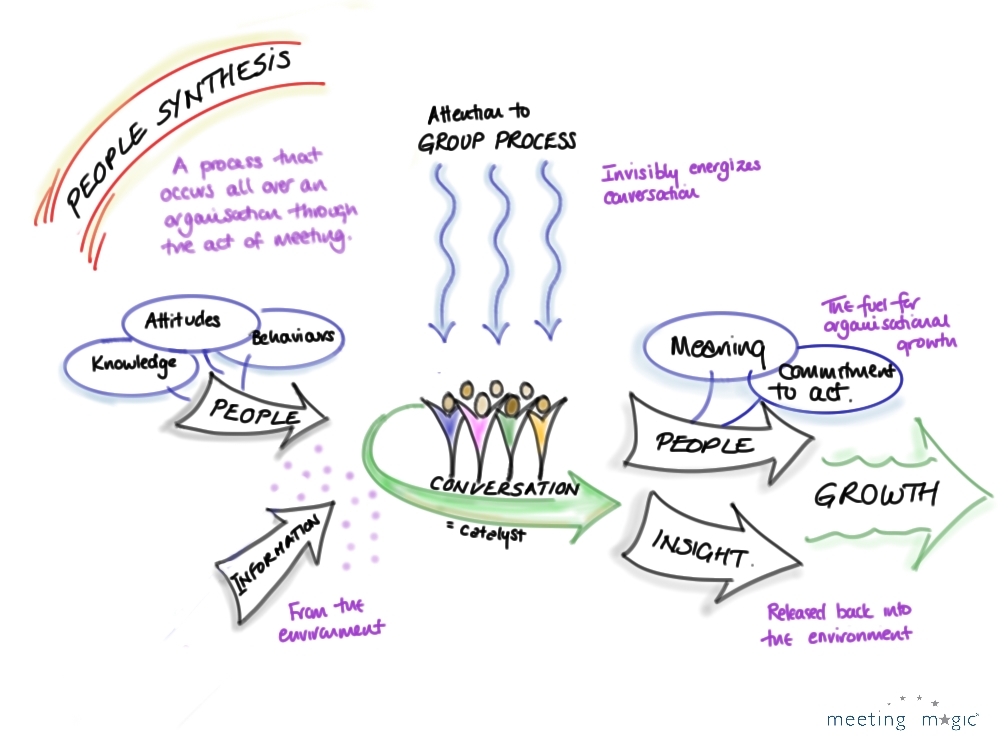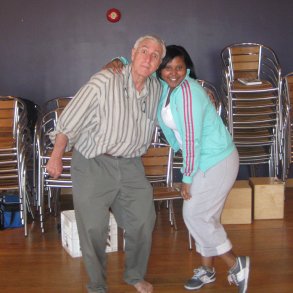By Katherine Woods and Kenda Gaynham for Enlivening Edge
The magic of meeting in the evolution of organisations
When you think about meetings, what comes to mind? We expect it isn’t all good! Most of us have had our fair, if not excessive, share of horribly unproductive and pointless ones. Some advocate doing away with them altogether.
Think of meeting as a verb, not a noun. Meeting as a verb. Not meeting(s) as a noun. What does this conjure up for you?
The act of meeting for us evokes all the promise of rich conversation, the dynamic sharing of ideas, true collaboration with others and energetic interaction. Most of us know what that feels like, too!
Yet, how often does the positive experience of meeting, as described above occur in an organisation?
Meetings are:
- everywhere in most organisations; formally and informally, face-to-face and virtually, people are meeting throughout the working day.
- both the forum and the process by which work gets done (or not) in organisations.
Whether it’s two people or 200, the opportunity for meetings to truly embody the act of meeting, every time, is immense. It is the pervasive nature of meetings that means there is great power in giving focus to how we meet:
- Power to SEE the current organisational operating model.
- Power to EVOLVE the operating model of the system.
The theme of this month’s Enlivening Edge newsletter is the complexity of scaling Teal. Our work over the last 16 years has been facilitating meetings, mostly for large complex organisations. Making shifts in these organisations can seem like boiling the ocean and many people who work in these organisations are ‘change weary’. This has lead us to a practical approach to scaling new ways of working, through meetings, to harness the power of meeting.
The act of meeting – through the metaphor of a living system
If we compare organisations to living systems like plants, then meeting is like photosynthesis.
Photosynthesis: Chlorophyll captures the sun’s energy and uses it to make sugars out of carbon dioxide from the air and water. The sugars fuel a plant’s roots, stems, and leaves so the plant can grow and thrive.
Compare this to how people meet in organisations, in ‘peoplesynthesis’….
Peoplesynthesis: When people meet they bring with them their knowledge, skills and attitudes. Information is also brought into meetings. Information is shared and explored through conversation to produce insight and meaning, which fuels action so an organisation can grow and thrive.
For photosynthesis to occur, a plant needs invisible light energy, which is absorbed by the catalyst chlorophyll.
For peoplesynthesis to occur, a group needs attention to group process, which is also invisible, and which catalyses robust conversation and collaboration.
Practical implications for scaling Teal in complex, large organisations
By using the pervasive operating system of meeting to evolve change in an organisation, the change grows from within, responsively.
In order to make the shift to Teal, in an established organisation, paying attention to how we meet can help in at least a couple of ways.
- Power to SEE the current organisational operating model, particularly aspects that are deeply rooted in the unconscious organisational system. By taking a developmental look at how people currently meet in an organisation, we can see ways of working that are often unconscious. Some of these patterns can be helpful and therefore amplified to support a shift towards Teal working, and some may be unhelpful and need addressing.
- Power to EVOLVE the operating model of the system. In large complex organisations, this is a simple pragmatic way to scale Teal. We can also reinvent how we meet in an organisation, by designing group processes that integrate Teal working practices.
By meeting differently, we give people an everyday experience of a new way of working, which is much more powerful than trying to persuade. Once people experience a new way of meeting, there is often a pull that gains momentum and enables scaling in an evolutionary way.
The skills required
To leverage meetings in the way we are describing requires a particular blend of developmental and process facilitation. Within the Teal movement there is a great deal of reference made to facilitation.
The particular type of approach we are referring to is the process facilitation developed from work by practitioners like Edgar Schein and David Sibbet. We find this type of facilitation is still a rare commodity and, because of its invisible nature, it requires depth of experience to execute well. Many people think that by seeing it, they can do it.
At the risk of mixing our metaphors, let’s compare this skill to driving a car. Katherine Woods describes it like this:
“I learnt to drive when I was 17 (yes, a very distant memory!) Up to this point in my life I had a great deal of experience of being driven, by my parents, by friends’ parents, in the school bus, etc. However, at no point did anyone suggest I might just get in a car and give it a go, without some expert supervision. Let alone would they have suggested that I drive other people.
When I started to learn to drive, with the support of a driving instructor, I became very aware of some things that I had been unaware of when I was being driven. For example, I had to consciously remember to ‘mirror, signal, manoeuvre’. By the time I passed my driving test, I had practiced driving enough times that I could drive safely, but I was still very conscious of what I needed to remember each time I got in a car. I had to be aware to ‘mirror, signal, manoeuvre’.
After a decade of driving, I could drive safely without having to over-think it. The ‘mirror, signal, manoeuvre’ mantra came to me like second nature. Anyone who was a passenger in my car would not have necessarily noticed what I was doing. Even so, I would not have considered myself a Lewis Hamilton, currently the #1 Formula One driver in the world. If I had wanted to take my driving to another level I would have needed to substantially develop my driving skills before launching onto the track!
Becoming a highly competent facilitator is like becoming a highly competent driver. You wouldn’t launch yourself or your colleagues onto a track to compete with Hamilton without a great deal of training and practice.”
So, here are the points we are making with relation to facilitation:
- Good facilitation is invisible to the untrained eye but is felt in the smoothness and quality of the experience – much like driving with a competent driver.
- It takes expert support to develop facilitation capability – whether that’s training, coaching, or co-facilitation with an expert facilitator.
- Practice in a variety of facilitation contexts brings a richness of experience that enhances what a facilitator brings to every subsequent group – there is no fast track for this.
- To reach an expert level in facilitation takes years of practice and ongoing development to achieve the proficiency needed to use innovative tools, without endangering the group.
And that last phrase is really key. Facilitators who are untrained and unpractised can endanger the success of the group.
They can influence groups to their own thinking. They can actually move groups to poor decisions and not gain critical alignment, agreement, and commitment. And, in the case of tension or conflict, can mishandle situations that have the potential for lasting damage for individuals and the group.
On the other hand, skill in this area
- supports the success of a group through the quality of thinking it encourages,
- guides robust discussion and decision making processes, and
- brings an appreciation and skill in dealing with group dynamics that can really amplify the impact that meeting has.
So, let’s stop having meetings and meet instead? Let’s create an environment that fosters true collaboration and considers the impact facilitation brings to it? If we are to embody Teal, we have a responsibility to facilitate and to learn to do so well.
 Katherine Woods, Founder and CEO, Meeting Magic Limited
Katherine Woods, Founder and CEO, Meeting Magic Limited
I founded Meeting Magic on a passion to help organisations leverage the way people work together when they meet. The Meeting Magic Network is operating in a manner that enables people to bring their whole selves to their work. Frederic Laloux’s work made a strong connection with me, for my client work and the way I organise the business. www.meetingmagic.co.uk
 Kenda Gaynham, Meeting Magic Limited
Kenda Gaynham, Meeting Magic Limited
I’m part of a great team at Meeting Magic. We work with forward-thinking clients across the world who achieve great things, both through the work they do together and how they work together. I bring my own passion and purpose to this work and we also seek to embody the principles and practices of a whole-hearted and soulful next-generation organisation in our own business. email: [email protected]






I appreciate the diagrams and insights here – especially the idea of thinking of meeting as verb not noun and “For photosynthesis to occur, a plant needs invisible light energy, which is absorbed by the catalyst chlorophyll. For people synthesis to occur, a group needs attention to group process, which is also invisible, and which catalyses robust conversation and collaboration.”
I’m not involved with a large organisation, but with a network which is transitioning into an organisation (and/or a network of loosely connected organisations). In my practical work I always work with one or more others (most usually in collaboration with Nikki Fishman as a co-catalyst).
I was therefore interested in the reference to “invisible (light) energy, which is absorbed by the catalyst (chlorophyll)” – and how that applies in the “enabling transition” situation in which I find myself.
My insight looking at this post is a recognition that when Nikki and I consider combining our effort with that of someone else it is always around the issue of energy. Do they bring energy? Do they add energy? Do they drain energy? If they add energy then we will move towards them so that we can work in a mutually beneficial way. It is energy and complementary vision/direction that draws us together.
We tend to think in analogies with less tightly defined boudaries than a leaf – things like an organisational group shaped like an amoeba; snow-flakes becoming a blanket of snow; individuals combining in swarms, herds and flocks; raindrops becoming streams, which become rivers, and because they have a shared energy to find their way to the sea they increasingly flow together… although they may also separate again to get around obstacles.. but usually reconnecting later and anyhow still heading to the sea.
I’m here in this group learning about what you describe as “people synthesis” and the importance of the processes that allow that to occur. Thank you for your post.
Thanks for your response Pamela. I am sorry I haven’t replied sooner due to client workload! I find your comments thought provoking and, alongside this I have been considering this metaphor further. I am wondering if the process I am considering is more about ‘infosynthesis’ rather than people synthesis – the people are like the leaf – the organism which is doing the processing. The information (in all forms, tandgible data, people’s thoughts and feelings….) is the thing that is being processed to become meaning and growth.
Hello
many thanks for the insights.
Could I “reuse” this article? I mean translate it in german and publish it? (on the website mentioned above)
Kind regards
Michael
Hi Michael,
We are pleased that you found the article useful and would be delighted if you want to share it by translating it into German and publishing it, thank you! It would also be great to hear if you have any responses to it, what they are….
Best wishes,
Kenda (and Katherine)
I have had the impression that approaches like “teal organizations” or even holacracy have a strong communication mechanism established. They seem to believe that if they create some standards that force communication, people will end up finding themselves the better decisions of what should be done and how it should be done.
That’s true?
I am really happy to find your article!
In my former position, as a leader and project manager I tried to held “good” = effective, meaningful meetings. The organizational culture was quite different, however they liked my meetings. But these were still meetings as a “noun”.
Now as a coach, trainer and facilitator enjoy the facilitated meetings, the inspiration and energy, the visualization, the joy of good work, deep interaction, etc..
I completely agree with you that facilitation is invisible but require skills, experiences, consciousness, maybe a certain type of personality, too.
My purpose to help organizations to find this joy of meetings (as a verb).
Encouraged by your former answer to Michael Wyrsch, I ask you the same question: can I use your article in my blog (teal.blog.hu) in Hungarian? I don’t want to translate it word-by-word but to give a summary and refer to your article.
Kind regards Gabi